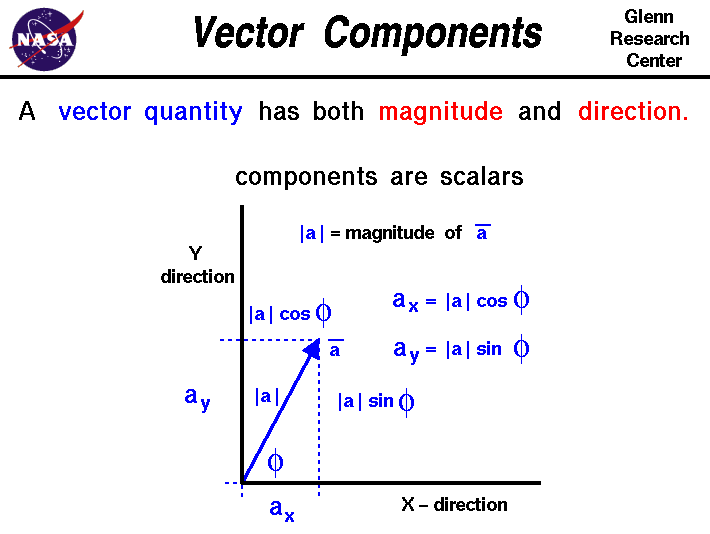
Math and science were invented by humans to describe and
understand the world around us.
We observe that there are some quantities and processes in
our world that depend on the direction in which
they occur, and there are some quantities that do not depend
on direction.
Mathematicians and scientists call a quantity
which depends on direction a vector quantity. A quantity
which does not depend on direction is called a scalar quantity.
A
vector quantity
has two characteristics, a magnitude and a direction. When
comparing
two vector quantities of the same type, you have to compare both
the magnitude and the direction.
On this slide we describe a mathematical concept which is unique to vectors;
vector components.
Vector components allow us to break a single vector quantity
into two (or more) scalar quantities with which we have more
mathematical experience.
Vector components are used in vector algebra to
add,
subtract, and multiply vectors.
Vectors are usually denoted on figures by an arrow.
The length of the arrow indicates the magnitude of the vector and the
tip of the arrow indicates the direction. The vector is
labeled with an alphabetical
letter with a line over the top to distinguish it from a scalar.
We will denote the magnitude of the vector by the symbol |a|. The direction
will be measured by an angle phi relative to a coordinate
axis x. The coordinate axis y is perpendicular to
x.
Note: The coordinate axes x and y are themselves
vectors! They have a magnitude and a direction. You first
encounter coordinates axes when you learn to graph. So, you have
been using vectors for some time without even knowing it!
If we construct a dashed line from the tip of the vector a
running parallel to the x-axis, it cuts the y-axis at a location we
label ay. Similarly, a line from the tip of the vector
parallel to the y-axis cuts the x-axis at ax. Using the
sine and cosine
relations from
trigonometry:
ay = |a| * sin(phi)
ax = |a| * cos(phi)
We call ax
the x-component of a, and ay the
y-component of a.
The component equations are scalar equations; |a| and the trigonometric
functions
are just scalars. Any algebra involved with
these quantities will be scalar algebra, not vector algebra.
We have in essence replaced the single vector quantity a
with two scalar quantities ax and ay.
Looking very closely at these two equations, we notice that they
completely define the vector quantity a; they specify
both the magnitude and the direction of a.
We can find the magnitude of the vector by using the
Pythagorean Theorem.
The components form two sides of a right triangle.
To determine the length of the hypotenuse of the triangle:
|a|^2 = ax^2 + ay^2
|a|^2 = |a|^2 sin^2(phi) + |a|^2 cos^2(phi)
|a|^2 = |a|^2 (sin^2(phi) + cos^2(phi) )
|a|^2 = |a|^2
|a| = sqrt(|a|^2)
Why go to all this trouble? Because, in aerospace, we are often dealing
with forces and
forces are vectors. Breaking a single vector force into several components
allows us to study the resulting motion much more easily.
Note: On this slide, for simplicity, we have developed the
components in only two dimensions; there are two coordinate axes.
In reality, there are three spatial dimensions and three components of
all forces. This is important in our derivation of the
general equations of
motion
for flight trajectories and for the
Navier-Stokes and
Euler equations which
describe the forces and resulting motion of fluids in the engine.
We can break very complex, three-dimensional, vector problems into
only three scalar equations.
Activities:
Guided Tours
Navigation ..





- Beginner's Guide Home Page
|
